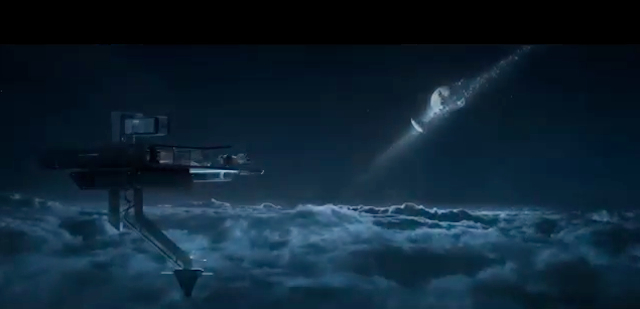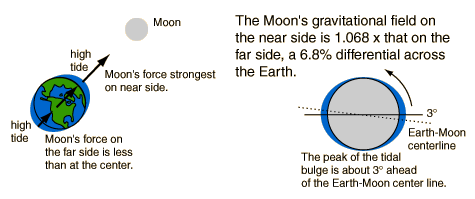I was alerted last week to the possibility that people might be asking questions about the scientific possibilities suggested in the movie Oblivion [1], released today. May I point out that ripping apart the science in movies like this is a form of entertainment for me? If you aren’t interested, go read someone else’s blog.
Shameless plug: You should go see Oblivion at Pacific Science Center in IMAX [2].
In order to address these issues, I have to talk about the movie, but I’m going to do my best not to spoil the whole thing since you might want to see it.
SPOILER ALERT
.
.
.
SPOILER ALERT
.
.
.
SPOLIER ALERT
.
.
.
In Oblivion [1] the year is 2077, and the Moon has been destroyed by robot aliens. This caused widespread destruction due to earthquakes and tsunamis. The tectonic activity has stabilized, but humanity has migrated to Titan. A few people are still on earth guarding the Hydro Rigs that convert seawater into energy for the Titan colony. The Moon is depicted as being half there, half a debris ring around the Earth.
Meteorites
Yes, and the movies doesn’t have any.
The method of the Moon’s destruction isn’t dwelled upon in the movie, but I get the impression it was a nuclear war. Let’s just assume the alien race has enough power to blow up the Moon, and they do so.
The first effect is going to be a huge number of meteorites slamming into the Earth. These aren’t going to be just a few that make some pretty craters, that’s a lot of mass up there in the Moon and a lot of it is going to come raining down on the Earth. I think this is going to be the most devastating effect. I’ll have to run some hypothetical math (or maybe Phil Plait or XKCD What-If will do it before me), but it seems like this rain of debris would be significantly more destructive than the meteor that probably killed off the dinosaurs. There will be more mass than that single meteor (a LOT more mass), and it will rain down over more of the planet. I suspect it will be moving more slowly though, so that may mitigate the effect a bit.
Last I heard the dinos died out either because of the ensuing nuclear winter (too much ash and dust in the atmosphere, cooling the climate) or a nearly instantaneous ignition/superheating of most of our atmosphere, which would have broiled everything aboveground leaving burrowing animals and sea-life alone. Whoo-ee. Someone check my references on that. (Jonas? Jonas? Why are you in New Zealand when I need you?). So, the Moon debris falling down would be very bad.
But somehow no meteorites from the lunar explosion.
Earthquakes
Sure. There could be earthquakes if the Moon blew up. Mostly due to IMPACTS FROM METEORITES. Barring those I’m having trouble envisioning why we would get earthquakes from the Moon breaking up in orbit. So my answer is:
Not the way they are in the movie.
The Moon does pull tidally on the Earth’s crust a little bit, but the effects are not the kind that we generally notice over the span of human lifetimes. Even by spreading out the mass of the Moon into more of a ring, you’ll also lose that tidal flex. I would expect that to make fewer earthquakes, not more. In the process of the Earth settling from a shape influenced by the Moon into a shape influenced by the debris ring we will have some earthquakes, but not ones that destroy cities.
If we were Jupiter’s moon Io, and it was Jupiter that was destroyed then yes, we would feel significant tectonic stress. But we’re not.
The Moon’s tidal forces do assist in keeping the Earth’s crust heated, and possibly impact the fact that we have moving tectonic plates in the first place. Now that tectonic plates have formed though, it will take a bajillion years to slow them down and stop them.
Tsunamis
Let’s say yes.
We all know the Moon is the major influencer on our tides here on Earth. The Moon and the Sun share the duties of causing the Earth’s tides, but the Moon does 2/3 of the work, and the Sun only does the leftover 1/3. So there’s a lot of water caught up in the tidal oval at any given time. The Earth rotates through that oval of influence, giving us two high tides per day.
Here’s a diagram of the tidal oval. It’s exaggerated a lot:
From: http://hyperphysics.phy-astr.gsu.edu/hbase/tide.html#stid [4]
That’s a LOT of water to displace, and most of it is at the equator. So if the Moon suddenly disappears, that peak will slosh back down and (after sloshing back and forth a lot) will settle into a more even distribution. With half the Moon still in place, we’ll only be redistributing about 1/3 of that water. Also, since the Moon’s debris is staying in orbit (forming a ring), we won’t need to displace the water towards the poles, it can stay concentrated near the equator. Even though that is a significant reduction, it’s still a lot of moving water, suddenly. That’s a tsunami: a LOT of ocean water being displaced suddenly.
A caveat: it looks in the movie as if those tsunamis carried a lot of sediment with them, enough to cover all but the very top of the Empire State Building. Tsunamis from the destruction of the Moon would have no reason to dredge up sediment from the bottom of the ocean, so I don’t know where it is implied that material came from. I have no problem with the water washing that high in a significant Moon event, but not mud or sand.
A Ring around the Earth
When you first see the movie you’ll say “Alice! That ring is around the Moon, not the Earth.” Just wait, later on it becomes visible as a ring around the Earth.
Yes and no.
I guess that’s my answer for all of these. This is the case where I need to pull out my solar system dynamics textbooks and run through some equations first though.
Yes: soon after the destruction of the Moon, any debris will end up in orbit, and a lot of that will be leading or following the Moon’s own orbit, since that’s where it originated. This will give us a lumpy ring. It won’t be as bright as in the movie, because it will be mostly dust and boulders. Saturn’s ring is very visible because it is mostly very reflective ice. Dust is darker.
Over 60 years (from the Moon’s destruction around 2017 or later until the time of the movie in 2077), some of that debris will have reentered the Earth’s atmosphere, and the rest will also still be orbiting in that ring.
Over a more extended period of time I don’t think the distance of the Moon’s orbit is a stable place for a ring system. The dust will either recoalesce into one or a few Moons, drift to a different orbit, or fall down to the Earth.
I haven’t had time to sit down and calculate any of this out, but these are my reasonably-well-educated guesses.
References
If We Had No Moon, Bernard Foing http://www.astrobio.net/index.php?option=com_retrospection&task=detail&id=2507 [5]
Sun’s Tidal Effect http://hyperphysics.phy-astr.gsu.edu/hbase/tide.html#stid [4]
365 Days of Astronomy http://cosmoquest.org/blog/365daysofastronomy/2009/03/28/march-28th/ [6]
NASA http://helios.gsfc.nasa.gov/qa_earth.html#quake [7]
.
.
.
SPOILER ALERT
.
.
.
SPOILER ALERT
.
.
.
SPOLIER ALERT
![]()
~ A l i c e !

